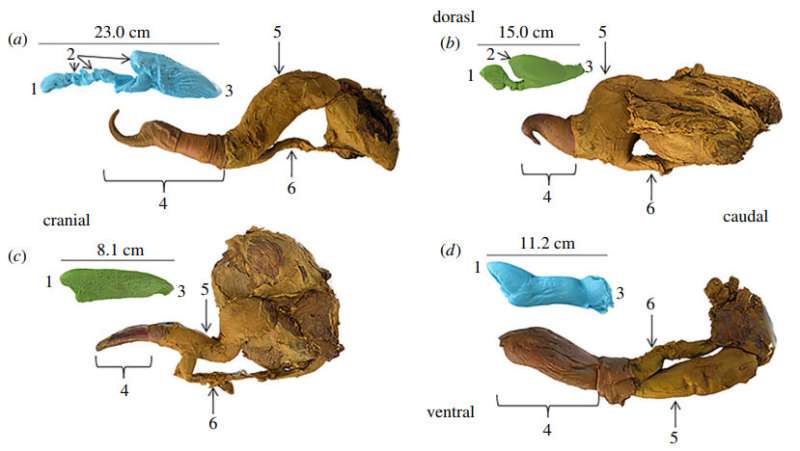October 11, 2017 report
Simulating cetacean sex with cadaver parts offers insight into marine copulation

(Phys.org)—A small team of researchers from Dalhousie University, the University of Massachusetts and Tufts University has learned more about the ways that cetaceans copulate by using parts from dead sea animals to simulate mating in the wild. In their paper published in Proceedings of the Royal Society B, the group describes the various techniques they used to simulate copulation and what they learned from doing so.
As the researchers note, very little work has been done to understand the sexual mechanics of cetaceans—out in the ocean, sex occurs at random times, making the behavior extremely difficult to study. In this new effort, the researchers sought to learn more by simulating copulation using the actual sex organs of deceased animals.
Cetaceans are marine animals that include whales, dolphins and porpoises. And despite our familiarity with all three types, very little is known about the mechanics of how they procreate. For that reason, the researchers worked with fishermen to obtain the bodies of some specimens that had died very recently of natural causes to use as research subjects.
To gain a better understanding of exactly what happens during copulation, the researchers removed the sex organs of several bottlenoses dolphins, common dolphins and harbor porpoises. Penises were inflated with saline solution and then slipped into vaginas to see how they fit and which parts of the organs of one gender interacted with which parts of the other. They also made casts of the various body parts and used them to simulate copulation as well. The team also placed some specimens mid-copulation inside of a CT scanner to create 3-D virtual models of the parts as they actually fit together during different movements that occur as the two animals mate.
The researchers report that they have learned a lot about the physiology of the animals they studied and how the whole process of cetacean copulation works. They also found that with the common dolphin, copulation tended to be what it seemed—a straightforward means of mating. But things were different with the harbor porpoises and bottlenose dolphins—the structure of the vagina was arranged such that the female could channel sperm away from her eggs if she so desired, allowing her to choose which male would inseminate her.
More information: Dara N. Orbach et al. Genital interactions during simulated copulation among marine mammals, Proceedings of the Royal Society B: Biological Sciences (2017). DOI: 10.1098/rspb.2017.1265
Abstract
Genitalia are morphologically variable across many taxa and in physical contact during intromission, but little is known about how variation in form correlates with function during copulation. Marine mammals offer important insights into the evolutionary forces that act on genital morphology because they have diverse genitalia and are adapted to aquatic living and mating. Cetaceans have a fibroelastic penis and muscular vaginal folds, while pinnipeds have a baculum and lack vaginal folds. We examined copulatory fit in naturally deceased marine mammals to identify anatomical landmarks in contact during copulation and the potential depth of penile penetration into the vagina. Excised penises were artificially inflated to erection with pressurized saline and compared with silicone vaginal endocasts and within excised vaginas in simulated copulation using high-resolution, diffusible iodine-based, contrast-enhanced computed tomography. We found evidence suggestive of both congruent and antagonistic genital coevolution, depending on the species. We suggest that sexual selection influences morphological shape. This study improves our understanding of how mechanical interactions during copulation influence the shape of genitalia and affect fertility, and has broad applications to other taxa and species conservation.
Journal information: Proceedings of the Royal Society B
© 2017 Phys.org



















